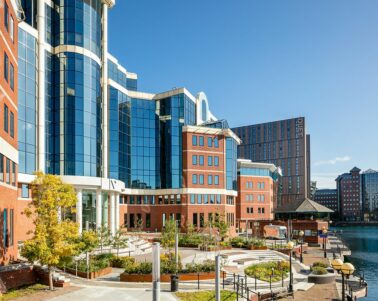For a period extending over 30 years, Salford Quays has witnessed a remarkable transformation, from a derelict wasteland in the mid-1980s following the closure of Manchester Docks, to a centre for media, innovation, business, culture, retail, sport and entertainment. Known as MediaCity, it has also simultaneously emerged as a highly desirable business hub, a cultural and retail destination and home to a thriving residential community.
Despite this success, like many places across the UK and globe, the pandemic and changing social attitudes and behaviours has prompted a rethinking towards the remaining phases of MediaCity to ensure its relevance and significance for current and future generations to come – this new chapter has been encapsulated as part of the MediaCity/Quayside Strategic Regeneration Framework (SRF).
Maximising economic and social impact
In bringing together the SRF, it’s not been enough to simply review and refresh the MediaCity Phase 2 proposals in isolation; instead, the ambition has been to maximise broader regeneration, economic and social impact. This is prompted by the recognition of the sheer scale of opportunity that exists at Salford Quays: at a local level, a widened site boundary includes not just MediaCity but also the neighbouring Quayside and its existing assets The Lowry and Lowry Plaza, alongside the local shopping centre – together this area has recently been designated as Salford Quays town centre. Meanwhile, the area forms part of Greater Manchester’s Central Growth Cluster, one of six growth locations within the region that is recognised as an opportunity to bring forward development at scale to deliver transformational change, reinforcing the relevance of MediaCity in the region and its recognition at a national level.
The renewed framework leverages this outstanding potential as well as the existing MediaCity assets, including the prime waterfront location and infrastructure, distinctive media and cultural anchors and job opportunities, and predominantly pedestrian-centric public spaces. Combined these present a scale of opportunity for delivering an additional 800,000 sqf of commercial office space, hotel accommodation, and supplementary retail, dining, and entertainment options across the 53-acre site.
Inspiring new spaces
Up to 3,200 much needed additional homes are also unlocked as an ecologically sustainable residential neighbourhood that encompasses a diverse array of housing options. It seeks to provide access to outdoor recreational spaces, local shops, services, and amenities, anchored by a new town square which links by a green pedestrian boulevard to the waterfront. Here, Oslo and Hamburg have served as inspiration, delivering renowned waterfront destinations which become the unifying heart of their respective City’s.
Whilst the designs honour the original radial and concentric configuration of the plan but also introduce a new scale—a human scale—characterized by urban canopies, pavilions, and smaller structures that facilitate a seamless transition to high-density zones. These will become home to a range of activities including retail and F&B, and build on the existing programme of temporary cultural events to bring a more defined and animated edge to Media Piazza and maximise the unique waterside aspect.
A network of pedestrian and cycle-friendly routes trace the water’s edge to connect all of the surrounding components and communities, and encourage a sequential gradual discovery of new spaces including natural play areas, outdoor education, grow spaces and outdoor culture and arts events.
A place where people can flourish
Communities needs and desires are perpetually changing, and evermore the success of our existing places need to evolve with them if they are to remain productive and successful grounds for human flourishment. The updated SRF for MediaCity/Quayside is an exemplar for how we can navigate this adaptation, seeking to think broader and more holistically about boundaries and impact across social, economic and environmental considerations. With the SRF recently endorsed by Salford City Council, the time is ripe to secure the powerful legacy of MediaCity for many generations to come.




